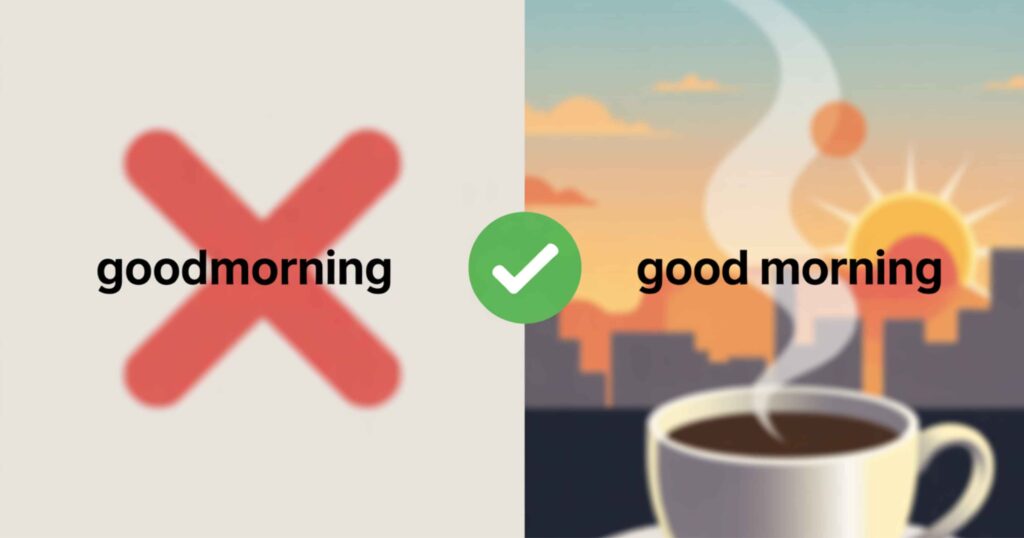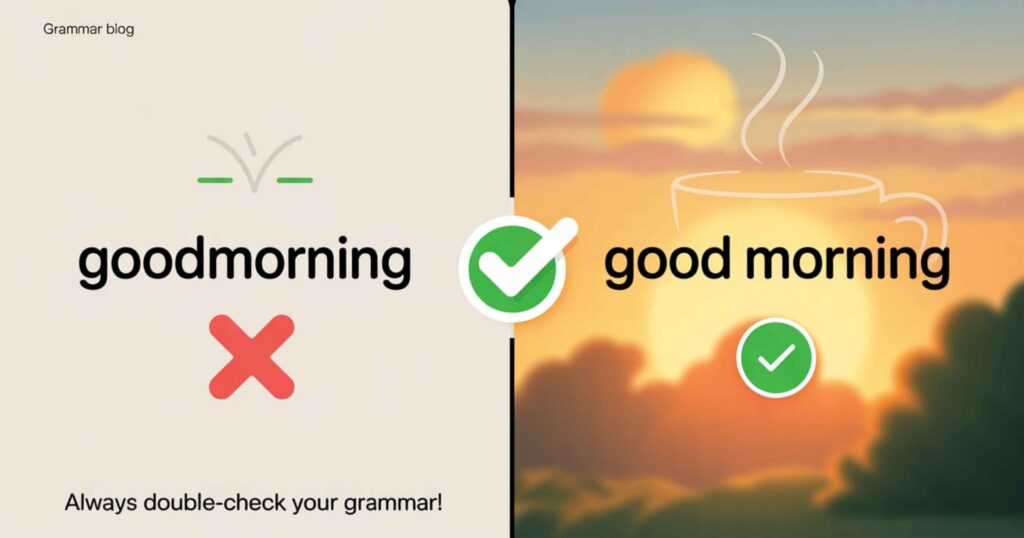You’ve probably typed it countless times today. Maybe in an email to your boss. Perhaps in a text to a friend. But have you ever paused and wondered: is it “goodmorning” or “good morning”? This simple morning greeting trips up more people than you’d imagine. Let’s clear up this confusion once and for all.
The difference between phrases like these matters significantly. Your professional reputation depends on getting basics right. One small spelling mistake can undermine your credibility instantly. But don’t worry—by the end of this article, you’ll never second-guess your morning communication tips again.
Understanding “Goodmorning” and “Good Morning”
Here’s the straightforward answer: “good morning” is always two words. The version “goodmorning” written as one word? That’s incorrect. Always has been, always will be.
This isn’t about being a grammar snob. It’s about mastering proper English usage that enhances your communication. Think about it—every email you send makes an impression. Every text message reflects your attention to detail. When you use correct word spacing consistently, people notice.
The goodmorning vs good morning debate shouldn’t even exist, honestly. Major dictionaries—Merriam-Webster, Oxford, Cambridge—all agree unanimously. Two words. No exceptions. No regional variations that change this rule.
But why does this confusion persist so stubbornly? Several factors contribute to this common spelling mistake:
- Compound words like “goodbye” create false patterns
- Typing quickly merges words accidentally together
- Autocorrect sometimes fails us miserably
- Social media’s casual nature breeds sloppy habits
- Non-native speakers struggle with English spacing rules
Why It’s Important to Get It Right
Professional credibility hinges on these small details. When you send an email starting with “goodmorning,” what message does that send? It suggests carelessness. It implies you didn’t proofread carefully. It makes readers question your attention to detail.
Standard English grammar isn’t optional in professional settings. Job applications get scrutinized intensely for basic errors. Client communications require polished, professional language throughout. Teachers and professors definitely notice these mistakes.
Your personal brand suffers from careless mistakes. First impressions matter tremendously in business correspondence. A single typo can cost you opportunities. That’s not an exaggeration—it’s documented reality.
According to a study by Grammarly, 59% of professionals say they wouldn’t trust a company that had obvious spelling or grammar mistakes on its website or marketing materials. Your morning greeting sets the tone immediately.
Is “Good Morning” One Word? and Is “Goodmorning” One Word?
Let’s address this directly and definitively. “Good morning” is two separate words. Period. The single-word version “goodmorning” has zero acceptance anywhere.
Major style guides confirm this universal truth:
- AP Stylebook: Two words always
- Chicago Manual of Style: Two words
- MLA Handbook: Two words
- APA Style Guide: Two words
No credible writing authority recognizes “goodmorning” as legitimate. Spell-checkers flag it immediately as incorrect. Professional editors correct it without hesitation.
But why do people assume it’s one? The answer lies in how English language skills develop over time. We see compound words daily—”breakfast,” “homework,” “butterfly.” These words formed from combining two separate words. Our brains naturally assume “good morning” follows that pattern.
It doesn’t. The proper greeting etiquette maintains these as separate words. “Good” functions as an adjective modifying “morning.” They work together grammatically but remain distinct.
Here’s a simple memory trick: if you can place another word between them naturally, they stay separate. “Good early morning” works perfectly. “Good-early-morning” as one word? That’s nonsense.
Breaking Down Each Phrase
Understanding the structure helps cement correct usage. Let’s examine both versions thoroughly and scientifically.
Good Morning: Definition and Proper Usage
“Good morning” serves as a conventional greeting phrase. It’s used from dawn until approximately noon. The phrase functions both as a noun and an interjection, depending on context.
Grammatically, “good” acts as an adjective. It modifies “morning,” the noun. This correct grammar structure requires keeping them separate. They maintain individual meanings while working together.
Examples across different contexts show proper usage:
- Email opening: “Good morning, Sarah. I hope this finds you well.”
- Casual text: “Good morning! Ready for coffee?”
- Business meeting: “Good morning, everyone. Let’s begin.”
- Phone call: “Good morning. How can I help you?”
The morning salutation appears in professional writing standards universally. Every major publication uses the two-word version. Newspapers, magazines, academic journals—all maintain this grammatical correctness consistently.
Dictionaries define “good morning” explicitly as two words:
| Dictionary | Definition | Parts of Speech |
| Merriam-Webster | “Used to express good wishes in the morning” | Noun/Interjection |
| Oxford | “A conventional expression at meeting or parting in the morning” | Exclamation |
| Cambridge | “Something you say to greet someone politely when you meet them in the morning” | Exclamation |
History of “Good Morning”
The phrase traces back to Middle English. Originally, people said “God give you good morrow.” That’s quite a mouthful, right? Over centuries, it shortened naturally to our modern version.
Victorian era writing formalized the two-word structure. Literature from that period consistently shows this proper formatting. Shakespeare used variations like “good morrow” in his plays. Charles Dickens wrote “good morning” in countless novels.
The language accuracy we expect today developed through these historical patterns. English evolved, but some rules remained constant. This greeting’s structure survived centuries unchanged.
Cultural variations exist across English-speaking countries worldwide. Americans, Brits, Australians, Canadians—all use the identical two-word form. This universal consistency proves the writing standards everyone follows.
Goodmorning: Why It’s Incorrect
No major English dictionary recognizes “goodmorning” as valid. It’s not a word. It’s a mistake. A typo. An error that needs correction.
This version fails basic English conventions completely. It doesn’t follow compound word rules. It creates confusion unnecessarily in formal writing. Professional editors universally reject it without hesitation.
Spell-checkers consistently flag “goodmorning” as wrong. Microsoft Word underlines it with red squiggles. Grammarly corrects it automatically. Every professional writing tool identifies this error.
Academic style guides reject it absolutely. You’d never see “goodmorning” in published books. Legal documents always use proper spelling. Corporate communications maintain language structure standards rigorously.
Common Causes of the Error
Why do people make this mistake repeatedly? Several psychological and practical factors contribute:
1. Pattern Recognition Gone Wrong Our brains love patterns. When we see “goodbye” (one word), we assume “goodmorning” follows suit. But English doesn’t work that logically. “Good night” is also two words, creating inconsistent patterns.
2. Speed Typing Habits Fast typing merges words accidentally. Your fingers move quicker than conscious thought. Before you know it, “goodmorning” appears on screen. This happens especially on smartphones and tablets.
3. Autocorrect Failures Technology doesn’t always save us here. Some autocorrect systems miss this particular error. Others correct it inconsistently across different apps. Relying solely on technology backfires sometimes.
4. Social Media Influence Informal platforms breed careless habits unconsciously. Twitter, Instagram, Facebook—these spaces prioritize speed over accuracy. Those habits then bleed into professional communication.
5. Non-Native Speaker Challenges English learners face particular confusion with correct word spacing. Their native languages might combine words differently. Transferring those patterns creates predictable mistakes.
Side-by-Side Comparison of “Good Morning” and “Goodmorning”

Let’s examine both versions through detailed comparison. This grammar comparison clarifies why one succeeds and one fails:
| Aspect | Good Morning (Correct) | Goodmorning (Incorrect) |
| Dictionary Status | Appears in all major dictionaries | Not recognized anywhere |
| Grammar Check | Passes all spell-checkers | Gets flagged immediately |
| Professional Use | Appropriate for all contexts | Never acceptable ever |
| Academic Writing | Universally accepted | Marked as error |
| Business Communication | Standard professional greeting | Damages credibility significantly |
| Published Literature | Appears in millions of books | Never appears legitimately |
| Email Correspondence | Perfectly suitable always | Appears unprofessional |
| Grammatical Function | Adjective + noun | Not applicable |
The usage difference couldn’t be clearer here. One version maintains grammatical standards universally accepted. The other represents a mistake requiring immediate correction.
Visual appearance also matters in text. “Good morning” looks balanced and proper. “Goodmorning” appears squished and uncomfortable. Readers notice these subtle visual cues subconsciously.
Rise and Shine: Inspiring Quotes to Start Your Morning Right!
Now that you’ve mastered the correct spelling, let’s celebrate mornings themselves! These morning wishes inspire and energize your day beautifully:
“Every morning brings new potential, but only if you utilize it.” – Unknown
This quote reminds us that opportunities don’t utilize themselves. You must take action daily. Each dawn offers fresh chances for growth.
“Morning is wonderful. Its only drawback is that it comes at such an inconvenient time of day.” – Glen Cook
Humor helps us embrace early rising’s challenges. Not everyone’s a natural morning person. That’s perfectly okay and completely normal.
“Good morning! Remember: A person can succeed at almost anything for which they have unlimited enthusiasm.” – Charles Schwab
Entrepreneurial wisdom starts with the right mindset. Your morning attitude determines your entire day. Choose enthusiasm over reluctance consciously.
“Each good morning we are born again. What we do today matters most.” – Buddha
Philosophical perspective transforms ordinary greetings into meaningful reflections. Yesterday’s mistakes don’t define today’s possibilities. Every sunrise offers renewal and redemption.
Using “Good Morning” in Everyday Language
Understanding correct spelling is just the beginning. Let’s explore how this polite greeting functions across different situations and contexts.
Formal Situations
Professional contexts require careful attention to proper greeting etiquette. Your workplace greeting sets the tone for entire interactions:
Business Email Examples:
- “Good morning, Mr. Thompson. Thank you for yesterday’s meeting.”
- “Good morning, team. Please review today’s agenda attached.”
- “Good morning, Dr. Martinez. I’m following up on our discussion.”
Interview Settings: Job interviews demand impeccable formal etiquette. Start with “Good morning, thank you for this opportunity.” This professional greeting demonstrates respect and preparedness simultaneously.
Client Meetings: “Good morning, everyone. Let’s discuss this quarter’s results.” Clear, confident, professional. Your daily greeting establishes authority and approachability together.
Informal Situations
Casual greeting contexts allow more flexibility and personality:
Text Messages: “Good morning! Coffee at 9?” Short, sweet, friendly. Your conversation tips can relax significantly with close friends.
Social Media Posts: “Good morning, beautiful people! Happy Friday!” Enthusiasm shines through naturally. Your morning message can include emojis and exclamation points freely.
Family Interactions: “Good morning, sweetie! Breakfast is ready.” Warmth and care characterize these everyday greeting moments perfectly.
Additional Contexts
Broadcasting: “Good morning, listeners! Welcome to today’s show.”
Customer Service: “Good morning! How can I assist you?”
Healthcare: “Good morning! How are you feeling today?”
Each context requires adjusting your greeting etiquette appropriately. Professional settings maintain formality consistently. Personal relationships allow creative flexibility naturally.
Common Mistakes and How to Avoid Them

Even knowing the difference, mistakes still happen regularly. Here’s how to eliminate common typos permanently through proven strategies.
Frequent Errors Beyond “Goodmorning”:
- “Goodafternoon” – Always wrong; use “good afternoon”
- “Goodevening” – Incorrect; should be “good evening”
- Capitalizing mid-sentence – Only capitalize at sentence starts
- Comma placement errors – “Good, morning” is completely wrong
- Hyphenation mistakes – “Good-morning” isn’t standard usage
These common misspellings persist because muscle memory overrides conscious thought. Fast typing creates automatic errors. Lack of proofreading tips implementation allows mistakes through.
Tips for Avoiding Errors
Practical Prevention Strategies for Writing Accuracy:
1. Enable Advanced Grammar Tools Install Grammarly, Microsoft Editor, or similar software. These tools catch frequent typos automatically. Browser extensions work across all platforms. Your spelling check becomes automatic and effortless.
2. Create Reusable Email Templates Pre-write common greetings correctly and permanently. Save them for instant access always. This typo prevention strategy saves time while ensuring accuracy.
3. Proofread Every Single Time Read messages aloud before sending them. Check greetings first specifically and carefully. Wait thirty seconds before hitting send. This error correction habit prevents embarrassing mistakes.
4. Study English Spacing Rules Understanding grammar principles prevents recurring mistakes. Learn which words combine legitimately always. Reference style guides regularly for confirmation.
5. Use Text Expansion Software Type “gm” to auto-expand correctly. Create shortcuts for frequently used phrases. Maintains consistency across all communication platforms.
Quick Tips for Accurate Morning Communication
Rapid-Fire Reminders for Language Improvement:
✓ Always use two words: “Good morning” forever ✓ Capitalize appropriately: Beginning of sentences only ✓ Add recipient names: Makes greetings more personal ✓ Match formality levels: Adjust tone to context ✓ Proofread consistently: Catches embarrassing mistakes ✓ Learn similar greetings: Good afternoon, good evening ✓ Practice daily: Builds correct muscle memory ✓ Read professional examples: Model successful communicators
Mnemonic Device for Memory: “Good things come in TWO words: Good Morning!”
This simple language advice helps cement proper usage. Your communication skills improve through consistent practice. Small habits create significant long-term improvements.
Conclusion
The goodmorning vs good morning debate ends definitively here. Only one version achieves acceptance universally. “Good morning” uses two separate words always. This morning salutation appears in countless daily communications.
Getting it right demonstrates professionalism and attention. Your credibility depends on these small details. Grammar mistakes undermine your expertise quickly and thoroughly. But now you possess definitive knowledge.
Standard English grammar isn’t negotiable in professional settings. These English rules exist for clarity and consistency. Your writing skills improve dramatically when you master basics. Language accuracy separates competent communicators from careless ones.
Start using “good morning” correctly in every communication. Proofread your messages before sending them always. Share this knowledge with colleagues who struggle. Your professional image will thank you sincerely.
Good morning to you, reader! May your communications always be clear, professional, and grammatically perfect. Now go forth and greet the world correctly with confidence and accuracy. Your improved English writing skills will open doors professionally. Master these fundamentals, and watch opportunities multiply naturally.

